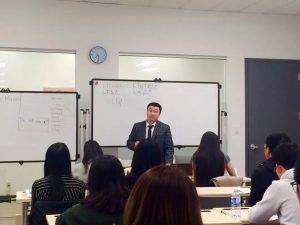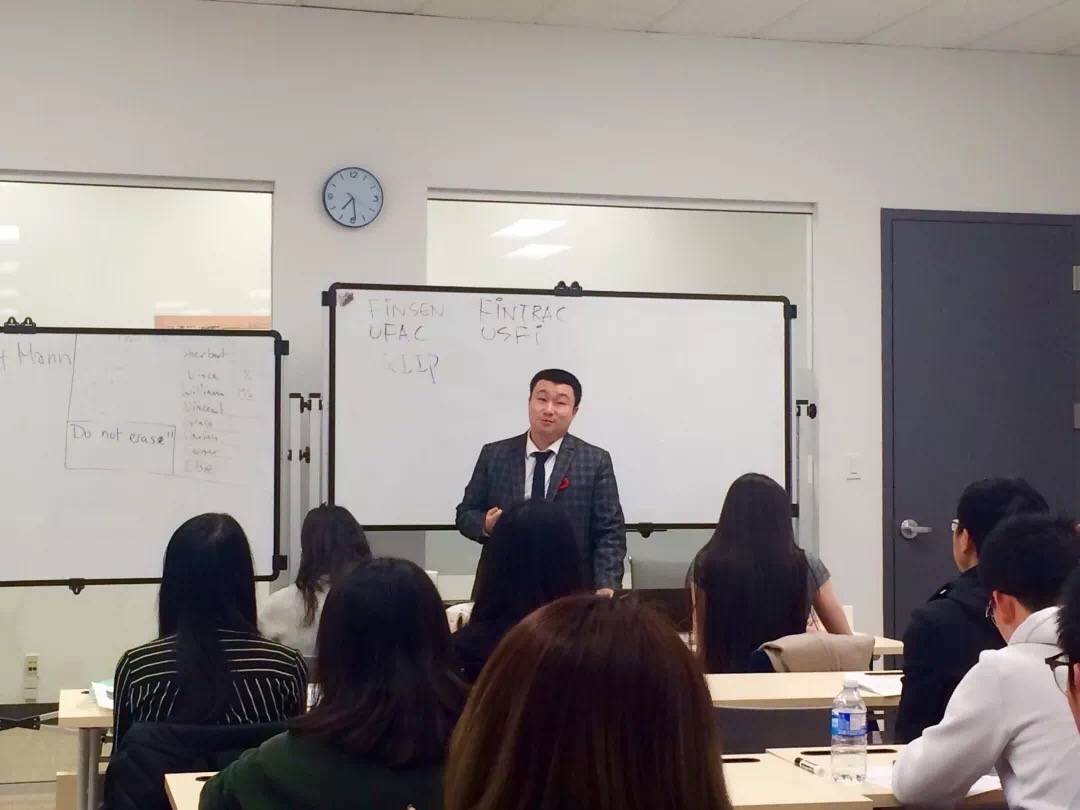In this AML 101, we are honoured to have Peter Su as our mentor. Through his talk in about 4 hours, he was able to share his knowledge and experience in the anti-money laundering industry with about 40 students.
– Event Summary –
 First of all, Peter started the first session with an overview of money laundering and the origin of today’s anti-money laundering (the “AML”) industry. Money laundering typically involves three major steps: Placement, Layering and Integration. In the placement stage, we often see criminals use different ways to get the illicit funds into financial institutions. It mostly involves depositing cash or other forms or legal tender/ financial instruments into bank or alternative financial services accounts (ie. Insurance and trade accounts). Layering means criminals disguise the source of illicit funds within financial institutions through complex financial transactions/ influx-outflux. Different activities are applied to cover up the source of fund, making the source harder to trace. Integration refers to the final stage in which illicit funds are fully disguised and consolidated into the criminals’ accounts. This serves the ultimate purpose of where the money laundering is to utilize the illicit funds for.
First of all, Peter started the first session with an overview of money laundering and the origin of today’s anti-money laundering (the “AML”) industry. Money laundering typically involves three major steps: Placement, Layering and Integration. In the placement stage, we often see criminals use different ways to get the illicit funds into financial institutions. It mostly involves depositing cash or other forms or legal tender/ financial instruments into bank or alternative financial services accounts (ie. Insurance and trade accounts). Layering means criminals disguise the source of illicit funds within financial institutions through complex financial transactions/ influx-outflux. Different activities are applied to cover up the source of fund, making the source harder to trace. Integration refers to the final stage in which illicit funds are fully disguised and consolidated into the criminals’ accounts. This serves the ultimate purpose of where the money laundering is to utilize the illicit funds for.
Conventional and “By-The-Book” Money Laundering Process
1. Placement – roll the illicit funds (mostly cash) into financial system
2. Layering – disguise the sources of fund within the financial system
3. Integration
After 9/11, governments around the world began to realize the importance of establishing anti-money laundry policies to fight against terrorist financing. In Canada, the implementation of AML programs within different banks are supervised by the Office of the Superintendent of Financial Institutions (the “OSFI”). AML has now been embedded into all three lines of defense. In the first line of defense, Relationship Managers have responsibilities to conduct Know Your Client (“KYC”) principles to understand their customers and transactions. Banks also rely on front line financial institution employees to follow KYC principles to mitigate risk. In the second line of defense, the Financial Intelligence Units (“FIU”) are responsible for the transaction monitoring, remediation and regulatory compliance areas. OSFI would set the framework and each FIU would set their own standard to their risk appetite. The FIU should periodically evaluate the effectiveness of the current compliances’ rules, and apply adjustment if necessary. Last but not least, the banks’ internal audits provide assurance to the execution of the first two lines of defense, also referred to as the 3rd line of defense.
Three Lines of Defense
1. KYC and Relationship Managers
2. FIU – Financial Intelligence Units, namely AML departments of each financial institution.
❖ Major duties of FIU:
a. Name Screen and Sanction List Management
b. Transaction monitoring
c. Regulatory compliances
d. Remediation
3. Internal audit
Some of the entry level jobs related to this area include KYC Analyst, Client Onboarding Specialist, Documentation Specialist and AML Investigator. There are multiple types of backgrounds that highly and explicitly valued by this industry. People with experience in retail banking can find themselves with relevant product knowledge and KYC experience. People working in accounting sectors can demonstrate their due diligence experience while interviewing for related positions. Law degrees are also highly valued in the industry.
Entry Level Job Titles for AML
● KYC Analyst
● Client Onboarding Specialist
● Documentation Specialist
● AML Investigator
AML Applicable Skills/Experience
● KYC
● Accounting skills
● Legal background – JD, Paralegal
● Trade finance experience
● Linguistic skills (Proper English writing and communication skills, highly demanded)
Banks generally apply risk basedapproach while managing risks of money laundering. This approach generallyinvolves 6 steps: identification of inherent risks, setting risk tolerance,creating risk-reduction measures and controls, evaluating residual risks,implementing risk based approach and reviewing the approach.
 In the first step, AML Analyststypically evaluate three areas while assessing money laundering risks: productcomplexity, geography, and clients and business relationships. In terms ofproduct complexity, it includes assessment on products, services and deliverychannels that may pose higher risks of money laundering. Canada suffered lessimpact of financial crisis in the past, and considered higher defense againstmoney laundering and terrorist financing, all thanks to its simplicity ofproduct varieties. (arguably due to its low pace on catching the ever changingfinancial world globally) Geography is also relevant on the basis that thelocation of business can be related to certain high risk landmarks, populationsor events. Lastly, the inherent risks linked to the nature and type of clients’businesses are also an important assessment factor.
In the first step, AML Analyststypically evaluate three areas while assessing money laundering risks: productcomplexity, geography, and clients and business relationships. In terms ofproduct complexity, it includes assessment on products, services and deliverychannels that may pose higher risks of money laundering. Canada suffered lessimpact of financial crisis in the past, and considered higher defense againstmoney laundering and terrorist financing, all thanks to its simplicity ofproduct varieties. (arguably due to its low pace on catching the ever changingfinancial world globally) Geography is also relevant on the basis that thelocation of business can be related to certain high risk landmarks, populationsor events. Lastly, the inherent risks linked to the nature and type of clients’businesses are also an important assessment factor.
In terms of risk tolerance, the bigfive banks don’t necessarily only keep low risk customers. In fact, mostfinancial institutions set their risk tolerance to moderate since they need tobalance the risks with revenue generating.
Risk Based Approach
Step 1: Identification of inherent risks
● Product complexity
● Customer risk – Geographical & PEP
● Related Party – POA, Delegates, Beneficiaries, etc.
Step 2: Set risk tolerance
Step 3: Create risk-reduction measure and Key controls
Step 4: Evaluate your residual risks
Step 5: Implement your risk-based approach
Step 6: Review your risk-based approach
Peter then discussed the general source of AML alerts. The common sources include Politically Exposed Person (the “PEP”), sanctions, adverse media, dedicated high risk business, and branch UAR (unusual activity report). PEP can be further separated into domestic PEP, foreign PEP, associated PEP and head of international organization (HIO’s). Additionally, AML alert can be triggered by adverse media such as news on corruption, bribery, allegation, and sentencing.
In Canada, AML industry generally follows the sanction list maintained by UN, OFAC (Department of the Treasury and Government of Canada). Sanctions can be further divided into country comprehensive sanctions, targeted sanctions and trade-based sanctions. Sanctions can be imposed on not only countries but also individuals and organizations.
AML Fielders’ Source of Work
1. System Threshold alerts (currently at 10k)
2. PEP – politically exposed person
❖ Sub categories:
a. DPEP – Domestic Politically Exposed Person
b. PEFP – Politically Exposed Foreign Person
c. Associate PEP – immediate family members of a PEP
d. HIO – Head of International Organizations
3. Sanctions list
4. Periodical review on targeted accounts.
5. Adverse Media (Negative News)
6. Dedicated High Risk Business
In the second session, Peter elaborated on the specific money laundering risks embedded in some of the high-risk industries. Some of the dedicated high-risk business types include used car dealerships, dealers of precious metals and stones, money service businesses, casino, BC notaries, white label ABM and real estate, etc.
For used car dealership, it usually involves large volume of trade based transactions. The value of the car is usually determined by the buying party and the dealer, creating arbitrage opportunities for under invoicing or over invoicing. In addition, drugs can be easily hidden in these cars.
Dealers of precious metals and stones (DPMS) also represent another high-risk sector for money laundering risks. Dealers pay cash to purchase inventory with values that can be easily manipulated. They then sell their inventory while receiving wires from their customers, thus allowing the once illegal money to enter into financial markets. Also, the value of precious metals and stones are also of subjective opinion and therefore could easily be manipulated. Finally they are easy to carry and may be well-interacted with human trafficking/ cross-border smuggling.
 White label ABMs allow users to withdraw cash. It will then charge the users a fee while receiving transfers for the withdrawn cash from the users’ bank accounts, thus potentially making the users surrender their legitimate banking capacities to their money laundering goals.
White label ABMs allow users to withdraw cash. It will then charge the users a fee while receiving transfers for the withdrawn cash from the users’ bank accounts, thus potentially making the users surrender their legitimate banking capacities to their money laundering goals.
Money service businesses are businesses that provide transactional money services such as FX boutiques, cheque cashers and payday lenders etc. They can be used to disguise the sources of wealth of the underlying fund.
In casinos, people can use cash they bring to play in the casinos and cash out in the forms of cheques, thus getting the cash into the financial systems. The games can also be manipulated in order to transfer cash to the legitimate gains of another party.
In BC, notary industry is self-regulated, creating potential risks for money laundering. People can potentially launder money by delivering bank drafts to the notaries in the closing stage without disclosing the source of the money. Additionally, money can be laundered through real estate purchase, firearms dealers and licensed marijuana dispensary as well.
Dedicated High-risk Business
1. Used car dealership
● Trade base with large volume
● Arbitrage opportunities (over/undervalued in price)
● Use car storage to transfer illicit goods/cash
2. DPMS: dealers of precious metals and stones
● Trade base business nature
● Transaction value can be over/under value
● Easy to carry and involved in human trafficking
3. White label ATM:
● Using illicit money in exchange for the legitimacy of banking system capacity
4. Money Service Business & Pay cheque lender
● Disguised source of funds by endorsing
5. BC notaries
6. Real estates, Firearms dealers, Licensed Marijuana Dispensary
Banks use two important reports for AML purposes. Unusual activity reports, also known as UAR, are usually filed discreetly by banking staff when they find customers’ behaviors to be unusual or suspicious. Large cash transaction reports (LCTR) are used to report significant cash deposits to banks as well. While UAR and LCTR being used for the banks’ internal controls, suspicious transaction reports (STR) are filed for regulators.
 A STR generally includes a few key sections: introductions to the triggering events, the simplified or extended KYC the bank has conducted on the case, the reason why the case is deemed to be reviewed and if there is any previous work to leverage from. It shall also include reviews on the account activities since the triggering date such as account transactions, related parties transactions, locations and denominations. At the end of the report, it generally has three kinds of decisions: do not report, suspicious transaction reporting/ demarketing and periodical review. The purpose of periodical review is to temporarily keep the suspicious account when the bank cannot make an informed decision on the account. It can help with the bank’s business while helping the bank to gain more account activities information to make a decision.
A STR generally includes a few key sections: introductions to the triggering events, the simplified or extended KYC the bank has conducted on the case, the reason why the case is deemed to be reviewed and if there is any previous work to leverage from. It shall also include reviews on the account activities since the triggering date such as account transactions, related parties transactions, locations and denominations. At the end of the report, it generally has three kinds of decisions: do not report, suspicious transaction reporting/ demarketing and periodical review. The purpose of periodical review is to temporarily keep the suspicious account when the bank cannot make an informed decision on the account. It can help with the bank’s business while helping the bank to gain more account activities information to make a decision.
AML Reports
● Internal control
○ UAR – Unusual Activity Reports
○ LCTR – Large Cash Transaction Reports
● Regulator control
○ STR – Suspicious Transaction Reports
○ Periodical review
In the end, Peter concluded the session by sharing a list of recruiting agencies to the students to help them look for an AML position in the future. Our students took this great opportunity to learn more about the anti-money laundering industry. We sincerely appreciate Peter and everyone else’s time and contribution to AML 101.

